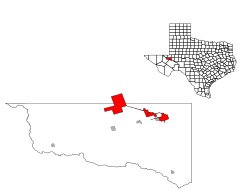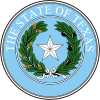Monahans, Texas
Monahans, Texas | |
|---|---|
City | |
 Air photo of part of Monahans facing northeast in 2012 | |
 Location of Monahans, Texas | |
| Coordinates: 31°35′16″N 102°53′26″W / 31.58778°N 102.89056°WCoordinates: 31°35′16″N 102°53′26″W / 31.58778°N 102.89056°W | |
| Country | |
| State | |
| Counties | Ward, Winkler |
| Government | |
| • Mayor | Adam Steen |
| Area | |
| • Total | 28.93 sq mi (74.93 km2) |
| • Land | 28.92 sq mi (74.90 km2) |
| • Water | 0.01 sq mi (0.03 km2) |
| Elevation | 2,621 ft (799 m) |
| Population (2010) | |
| • Total | 6,953 |
| • Estimate (2019)[4] | 7,816 |
| • Density | 270.26/sq mi (104.35/km2) |
| Time zone | UTC−6 (Central (CST)) |
| • Summer (DST) | UTC−5 (CDT) |
| ZIP code | 79756 |
| Area code(s) | 432 |
| FIPS code | 48-48936[2] |
| GNIS feature ID | 1363045[3] |
| Website | www.cityofmonahans.org |
Monahans is a city in and the county seat of Ward County, Texas, United States.[5] A very small portion of the city extends into Winkler County. The population was 6,953 at the 2010 census. In 2018, the population was estimated at 7,669.
History[]
This section does not cite any sources. (May 2017) |

The Permian Basin, home to Monahans and Midland-Odessa combined statistical area, is 250 miles (400 km) wide and 300 miles (480 km) long; Monahans is "The Center of the Permian Basin". The basin was formed during the Permian period, the final portion of the Paleozoic era. At the time, it was an ocean filled with abundant aquatic life.
In 1583, Spanish explorer Antonio de Espejo crossed this area on his way through present-day New Mexico. The Indians in the Monahans region were called vaqueros by these Spanish explorers because they hunted the "hump-backed cattle" or bison. Records of Spanish exploring the Los Medanos (the sand dunes) outside Monahans can be traced to the early 1770s.
Located in a region where native Comanches, Mescalero, and Lipan Apache Indians once roamed, Monahans' history as a community extends back to the late 1880s with the expansion of the Texas and Pacific Railway across the South Plains. For the few people living in West Texas, the building of a transcontinental railroad through the area meant the arrival of civilization. In the summer of 1881, Texas and Pacific Railroad contracted with surveyor John Thomas Monahan, who discovered that the lack of water for the laying crew and their animals would slow down construction of the rail. Monahan's digging of a water well produced an abundance of good water (250,000 US gal (950,000 L) a day) and was instrumental in the success of the city. Prior to this solution, water had to be hauled to the area from Big Spring, Texas.
The availability of cheap land encouraged settlers to form a small community on the track known as Monahans Well. When oil was discovered in the area in 1926, though, the community changed directions. Oil discovery brought people of many occupations and of varied interests to Monahans. The local economy began to change from an agricultural to an industrial economy.
Monahans Sandhills State Park[]
Thousands of tourists each year visit Monahans Sandhills State Park near Monahans. Sand surfing and sand football games can be seen year round, but particularly between March and November. Monahans Sandhills State Park is host to many family picnics and youth activities. The park is also a site for weddings.[citation needed]
Geography[]
Climate[]
| hideClimate data for Monahans, Texas (1981–2010) | |||||||||||||
|---|---|---|---|---|---|---|---|---|---|---|---|---|---|
| Month | Jan | Feb | Mar | Apr | May | Jun | Jul | Aug | Sep | Oct | Nov | Dec | Year |
| Record high °F (°C) | 87 (31) |
91 (33) |
100 (38) |
106 (41) |
114 (46) |
120 (49) |
115 (46) |
110 (43) |
108 (42) |
104 (40) |
92 (33) |
86 (30) |
120 (49) |
| Average high °F (°C) | 61.8 (16.6) |
66.5 (19.2) |
74.4 (23.6) |
83.4 (28.6) |
91.5 (33.1) |
97.5 (36.4) |
98.6 (37.0) |
97.0 (36.1) |
91.1 (32.8) |
82.5 (28.1) |
70.7 (21.5) |
61.8 (16.6) |
81.4 (27.4) |
| Average low °F (°C) | 28.6 (−1.9) |
33.0 (0.6) |
39.5 (4.2) |
48.2 (9.0) |
58.0 (14.4) |
67.0 (19.4) |
69.2 (20.7) |
68.5 (20.3) |
61.7 (16.5) |
50.5 (10.3) |
37.7 (3.2) |
29.1 (−1.6) |
49.3 (9.6) |
| Record low °F (°C) | −9 (−23) |
−8 (−22) |
12 (−11) |
25 (−4) |
35 (2) |
45 (7) |
50 (10) |
50 (10) |
33 (1) |
22 (−6) |
10 (−12) |
5 (−15) |
−9 (−23) |
| Average precipitation inches (mm) | 0.54 (14) |
0.71 (18) |
0.53 (13) |
0.57 (14) |
1.60 (41) |
1.35 (34) |
1.61 (41) |
1.73 (44) |
2.03 (52) |
1.63 (41) |
0.58 (15) |
0.67 (17) |
13.54 (344) |
| Average snowfall inches (cm) | 0.2 (0.51) |
0.0 (0.0) |
0.1 (0.25) |
0.0 (0.0) |
0.0 (0.0) |
0.0 (0.0) |
0.0 (0.0) |
0.0 (0.0) |
0.0 (0.0) |
0.0 (0.0) |
0.1 (0.25) |
0.3 (0.76) |
0.8 (2.0) |
| Source: NOAA[6] | |||||||||||||
Demographics[]
| Historical population | |||
|---|---|---|---|
| Census | Pop. | %± | |
| 1930 | 816 | — | |
| 1940 | 3,944 | 383.3% | |
| 1950 | 6,311 | 60.0% | |
| 1960 | 8,567 | 35.7% | |
| 1970 | 8,333 | −2.7% | |
| 1980 | 8,397 | 0.8% | |
| 1990 | 8,101 | −3.5% | |
| 2000 | 6,821 | −15.8% | |
| 2010 | 6,953 | 1.9% | |
| 2019 (est.) | 7,816 | [4] | 12.4% |
| 1930-2000,[7] 2010[8] | |||
As of the census[2] of 2000, 6,821 people, 2,496 households, and 1,837 families were residing in the city. The population density was 274.9 people per square mile (106.2/km2). The 3,015 housing units averaged 121.5 per square mile (46.9/km2). The racial makeup of the city was 79.30% White, 5.16% African American, 0.35% Native American, 0.35% Asian, 12.55% from other races, and 2.29% from two or more races. Hispanics or Latinos of any race were 43.66% of the population.
Of the 2,496 households, 38.3% had children under the age of 18 living with them, 56.4% were married couples living together, 13.5% had a female householder with no husband present, and 26.4% were not families. About 24.3% of all households were made up of individuals, and 12.7% had someone living alone who was 65 years of age or older. The average household size was 2.68, and the average family size was 3.19.
In the city, the age distribution was 30.3% under 18, 8.2% from 18 to 24, 25.7% from 25 to 44, 21.5% from 45 to 64, and 14.3% who were 65 years of age or older. The median age was 36 years. For every 100 females, there were 93.1 males. For every 100 females age 18 and over, there were 89.4 males.
The median income for a household in the city was $30,349, and for a family was $36,726. Males had a median income of $31,307 versus $18,086 for females. The per capita income for the city was $14,100. About 14.7% of families and 16.5% of the population were below the poverty line, including 17.1% of those under age 18 and 18.1% of those age 65 or over.
In December 2015, the Seattle Post-Intelligencer voted Monahans fifth among the 10 "most conservative" cities in the United States in regard to campaign contributions. Other West Texas communities in the most conservative lineup are Hereford (first), Dalhart (fifth, tie), and Childress (9th). Princeton in Collin County north of Dallas ranked second.[9]
Government and infrastructure[]
The Texas Department of Criminal Justice operates the Monahans District Parole Office in Monahans.[10]
The United States Postal Service operates the Monahans Post Office.[11]
Education[]
Public education in the city of Monahans is provided by the Monahans-Wickett-Pyote Independent School District.
Notable people[]
- Dale Dudley, Texas Radio Hall of Fame member, host of Dudley and Bob Morning Show on KLBJ FM in Austin, spent part of his childhood in Monahans.
- Guy Clark, a songwriter and country musician, mentioned the city in his songs and in the 1997 live album Keepers during a musical interlude.
- Kathy Whitworth, a professional golfer in Texas Sports Hall of Fame and World Golf Hall of Fame, was born here.
- Natalie Zea, an actress in the television series Justified, went to high school in Monahans.
- Deanna Dunagan is a Tony Award-winning actress who has made a prolific career acting on the Chicago stage. Originally from Monahans, Dunagan made her Broadway debut in the 1979 production of George Bernard Shaws Man and Superman at the Circle In the Square.
Transportation[]
The Texas-New Mexico Railroad operates a 111-mile (179 km) branch line from a connection with the Union Pacific at Monahans. The branch line was constructed between 1928 and 1930 and terminates at Lovington, New Mexico.
Major highways[]
References[]
- ^ "2019 U.S. Gazetteer Files". United States Census Bureau. Retrieved August 7, 2020.
- ^ Jump up to: a b "U.S. Census website". United States Census Bureau. Retrieved 2008-01-31.
- ^ "US Board on Geographic Names". United States Geological Survey. 2007-10-25. Retrieved 2008-01-31.
- ^ Jump up to: a b "Population and Housing Unit Estimates". United States Census Bureau. May 24, 2020. Retrieved May 27, 2020.
- ^ "Find a County". National Association of Counties. Retrieved 2011-06-07.
- ^ "NOWData - NOAA Online Weather Data". National Oceanic and Atmospheric Administration. Retrieved May 6, 2013.
- ^ Texasalmanac (PDF-Datei; 1,13 MB). Retrieved 2013-08-01
- ^ U.S. Census Archived 2013-07-08 at the Wayback Machine. Retrieved 2013-08-01
- ^ Daniel DeMay (December 17, 2015). "The most liberal and most conservative cities in the US". The Connecticut Post. Bridgeport, Connecticut. Retrieved December 20, 2015.
- ^ "DIRECTORY - REGIONAL AND DISTRICT PAROLE OFFICES REGION V Archived 2010-01-25 at the Wayback Machine." Texas Department of Criminal Justice. Retrieved on July 28, 2010.
- ^ "Post Office Location - MONAHANS Archived 2011-07-16 at the Wayback Machine." United States Postal Service. Retrieved on July 28, 2010.
External links[]
- Cities in Texas
- Cities in Ward County, Texas
- Cities in Winkler County, Texas
- County seats in Texas



